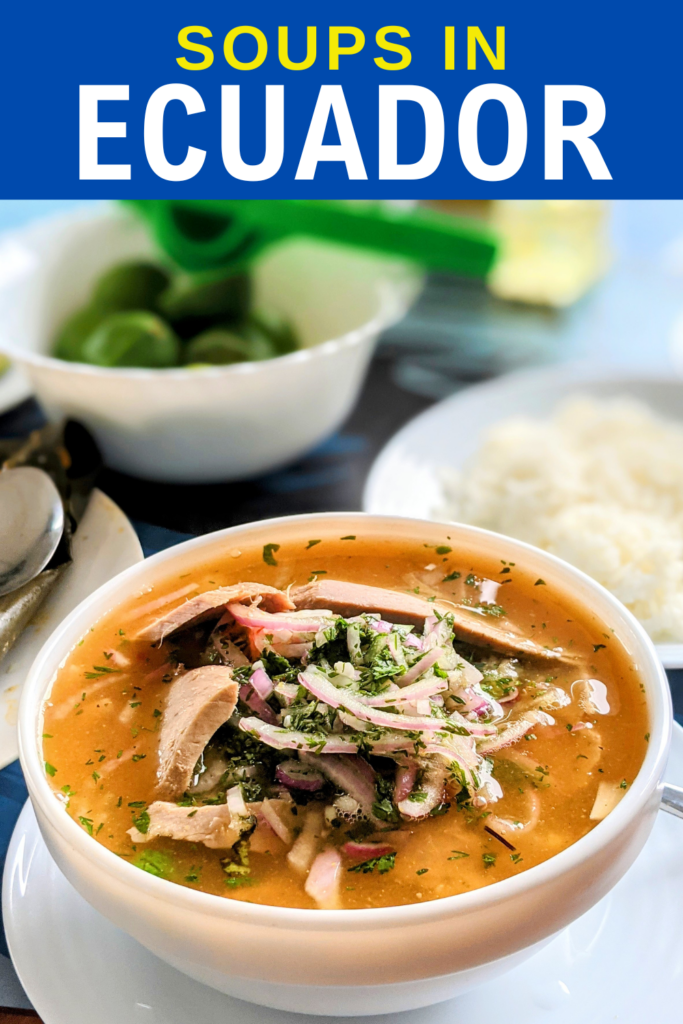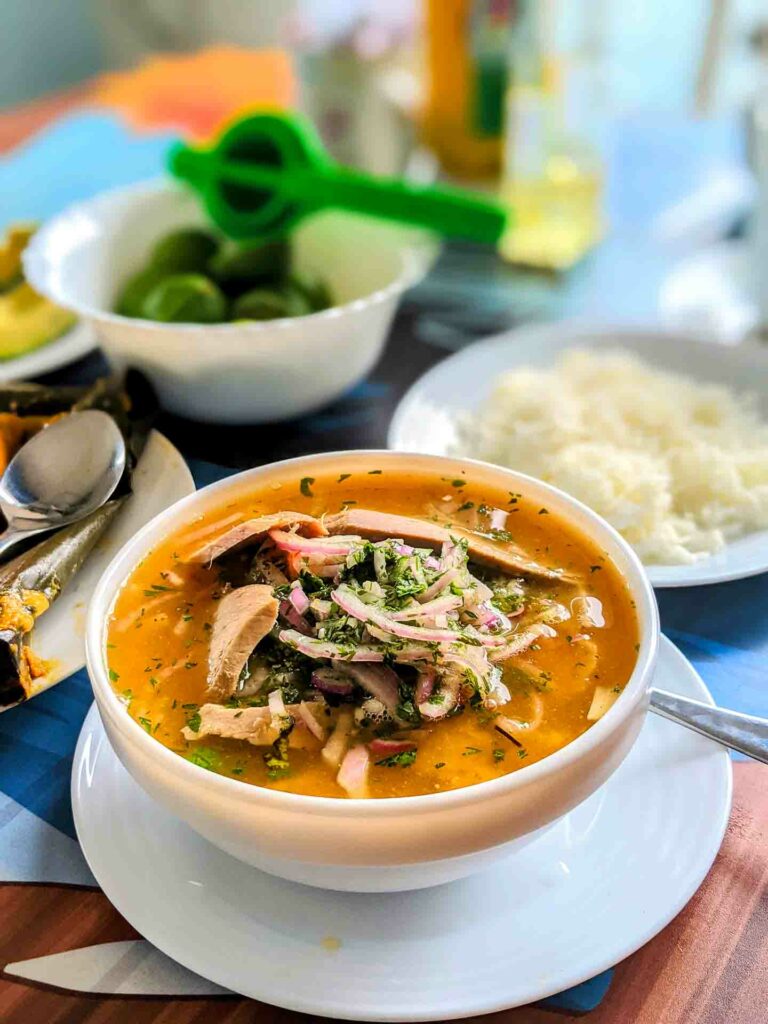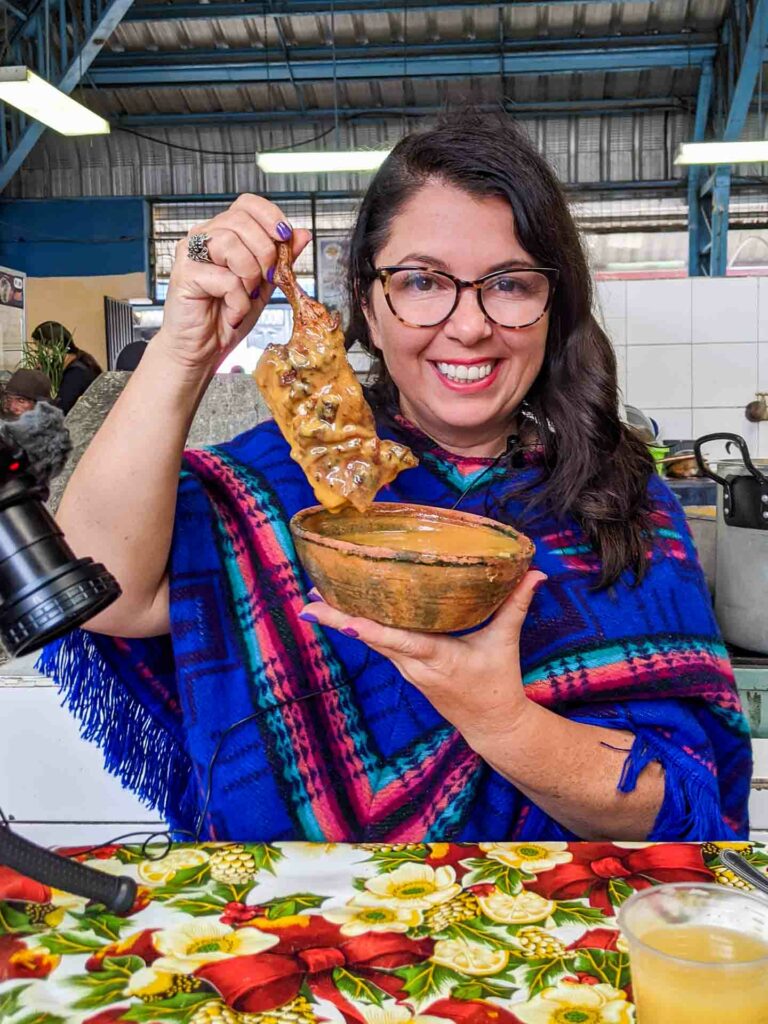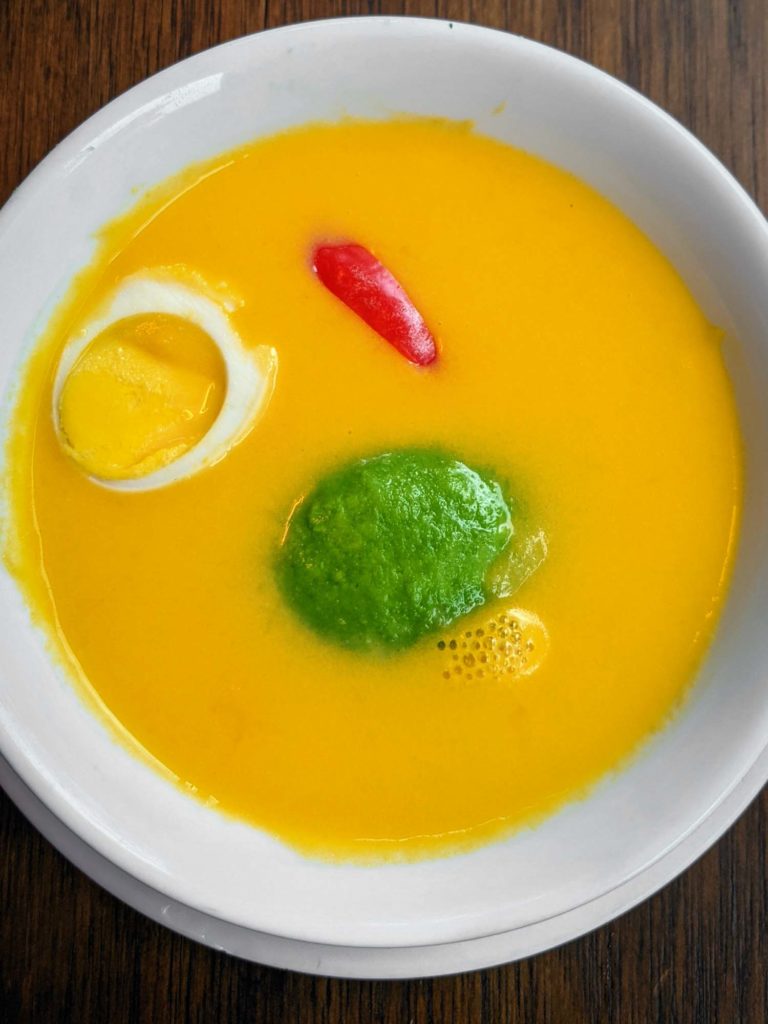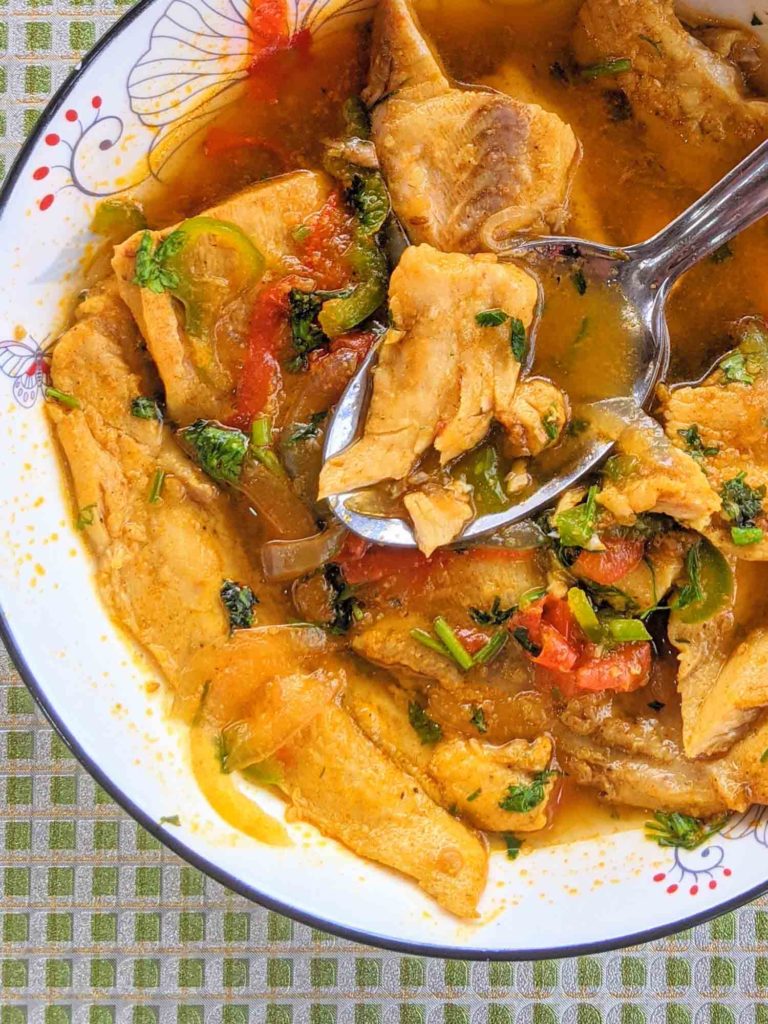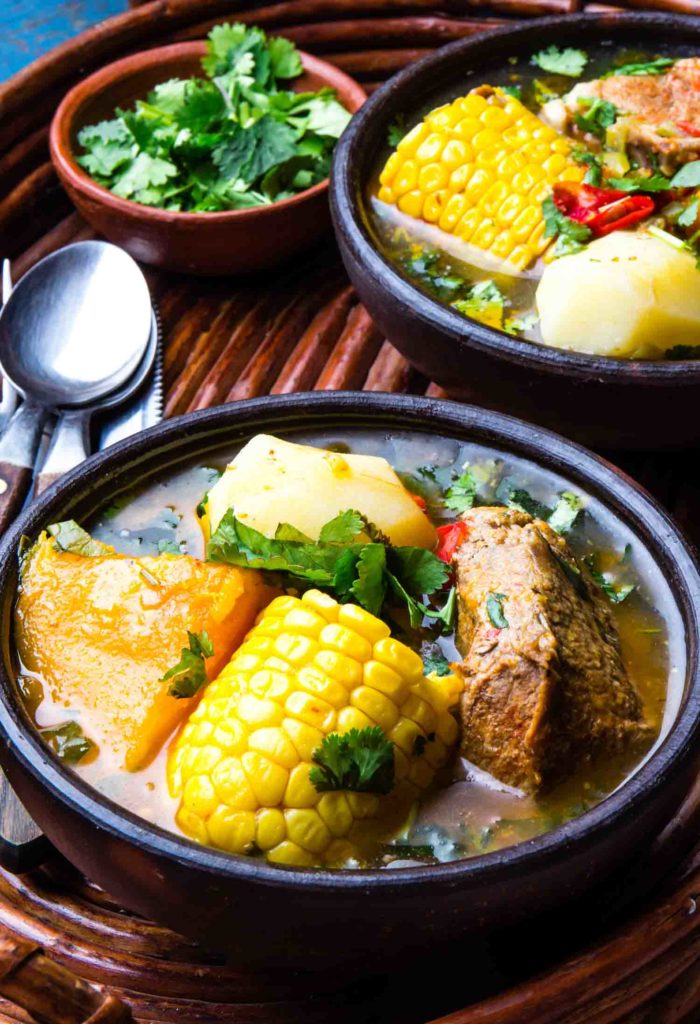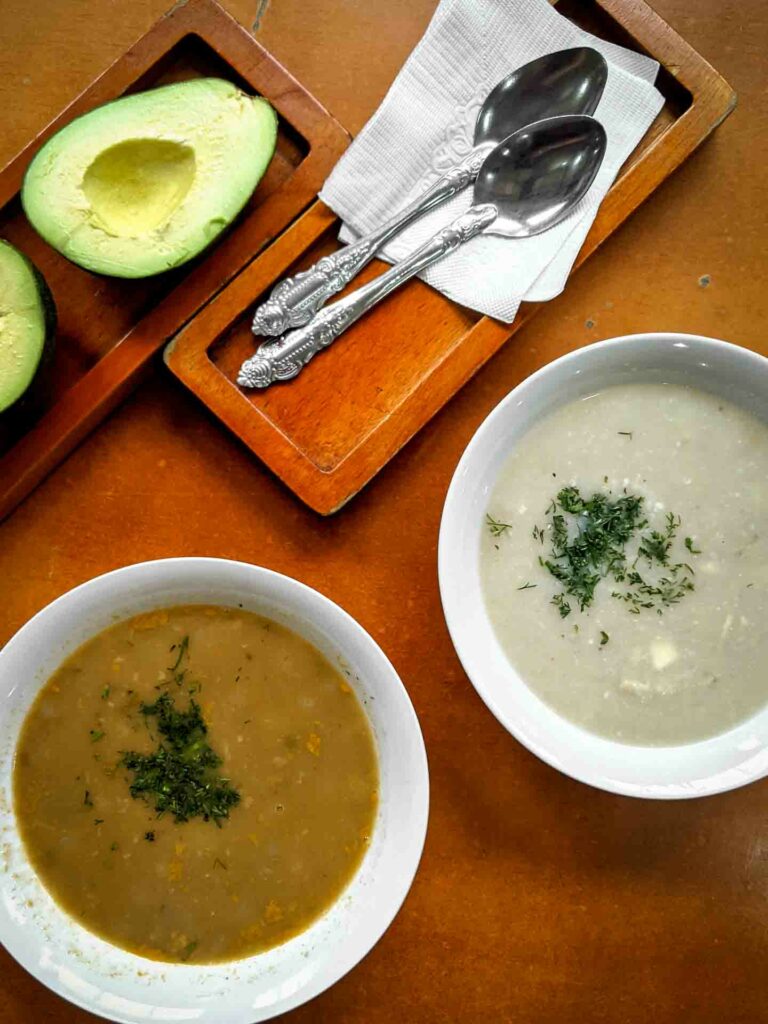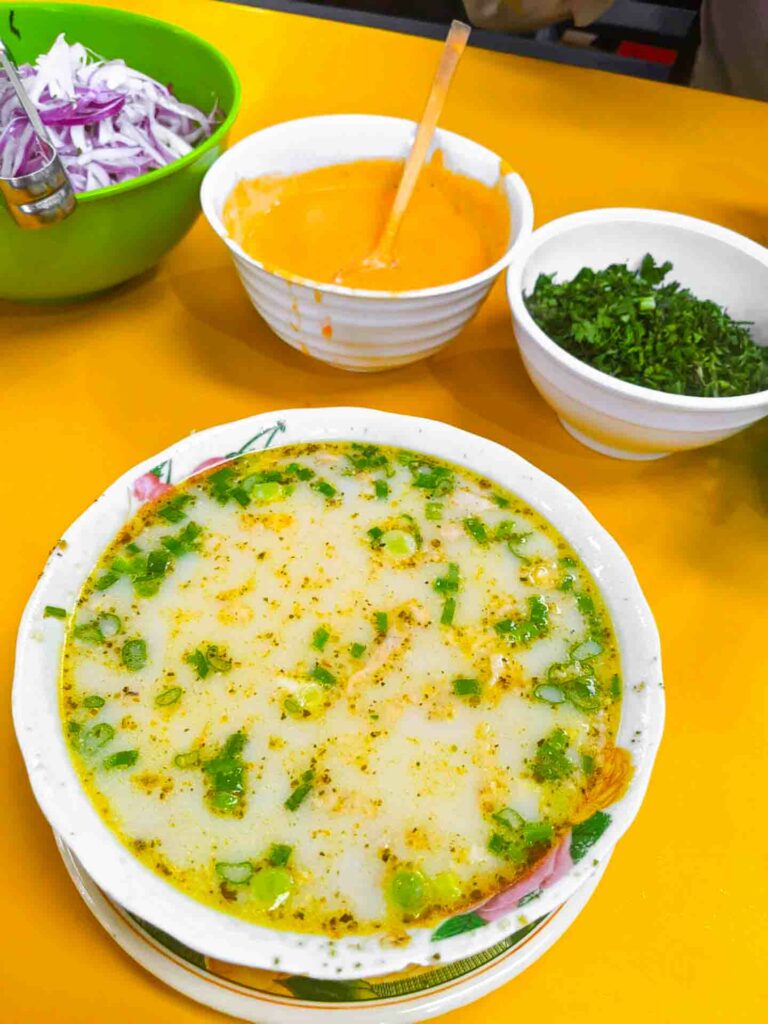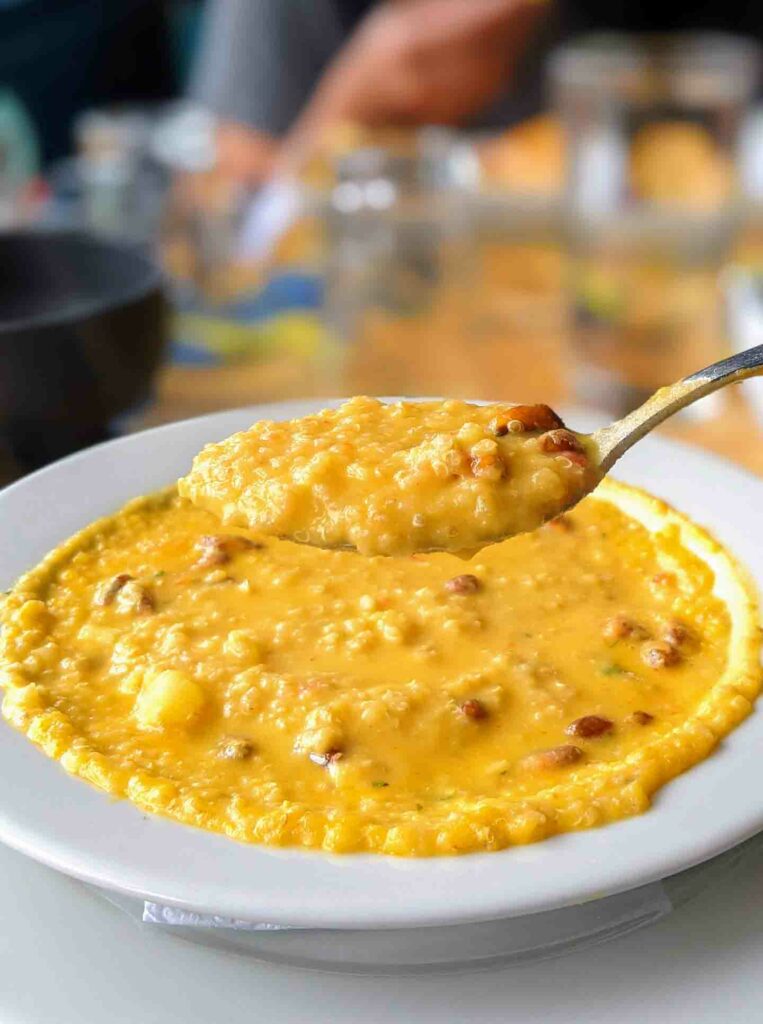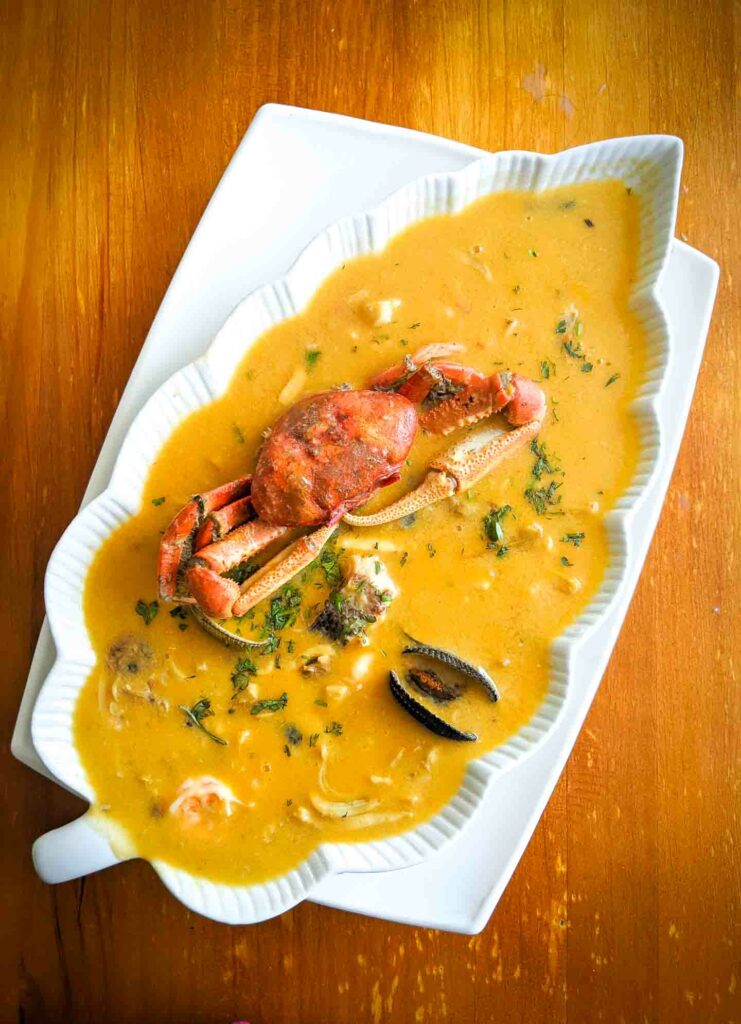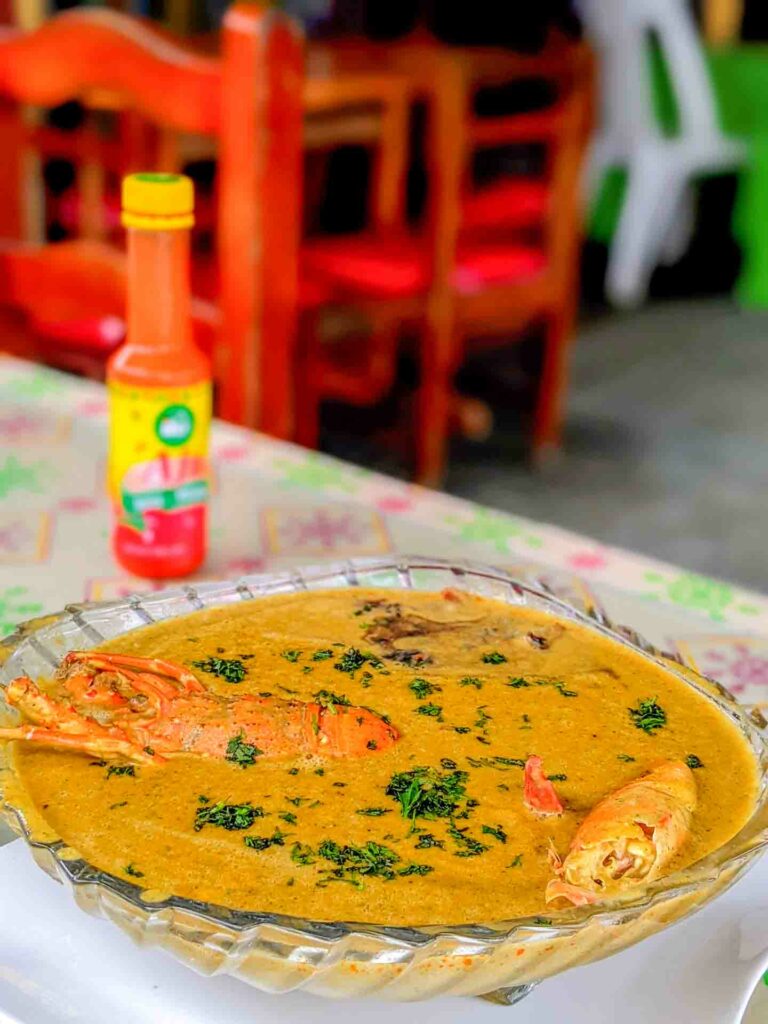An entire list dedicated to Ecuadorian soups? You bet, it’s known as the land of soup and you’ll want to start with because you’ll want to try all of them!
Let’s face it, soup does not get enough attention in Canada and the United States. Sure we have soup, but we don’t get excited about them.
We certainly don’t eat soup for breakfast.
But around the world, soup isn’t just for cold weather or only eaten at lunch. Soup in Ecuador is regional, it is different whether you’re in the Andes or on the coast.
In fact, food anthropologists say Ecuador has the second most number of soups, only trumped by China.
Ecuadorian Food
Garnishes, yes there are soup accompaniments, change from plantains, to toasted corn to popcorn or bread. It depends on where you eat it.
But if you’re served soup you can always expect to have avocado and aji (Ecuadorian hot sauce) on the table.
And in Ecuador soup for breakfast is common!
Believe me once you have soup for breakfast you’ll never want cereal again.
21 Traditional Ecuadorian Soups
Encebollado
Best breakfast in the world?
I waited ONE MONTH for this breakfast in Ecuador.
Ecuador is small enough that you can get fish in the Andes and pork along the coast. But I prefer to eat food where it’s from.
And encebollado is one of my absolutely favourite breakfasts ON EARTH.
The national dish of Ecuador, encebollado is known as a hangover cure and so it’s very popular on Sundays.
But you can get it any day of the week.
It’s a soup with local albacore tuna, lots of red onion, yuca and fresh herbs in a rich fish stock that tastes so fresh and light.
On the coast you’ll get a side of plantain chips and/or a specific bread called enrollado with it.
And in the Andes you find locals eating it with popcorn and it roasted corn called tostado.
It’s served along with fresh limes to squeeze in the broth and purists may allow some aji, which is spicier on the coast but that is all.
Fanesca
The most traditional soup in Ecuador, you can only find it once a year.
Fanesca is a rich, creamy soup traditionally served during Holy Week in Ecuador as a way to give thanks.
It’s a blend of grains, legumes, and salt cod. This dish is found throughout the country, with regional variations.
It’s a time intensive dish and while the two key components are 12 beans to represent the twelve apostles and Jesus is represented by the salt cod. Remaining ingredients also represent specific religious figures such as Mary and St.Peter.
Fanesca symbolizes Ecuador’s Catholic heritage. However, its roots are in Indigenous beliefs from the holiday of Muchuc Nina known as New Fire Day.
It celebrates Spring equinox and occurs in March. It is celebrated with Andean pumpkin and a number of grains and is considered the inspiration for fanesca.
Colada de Cuy | Guinea Pig Soup
Colada de cuy is a unique Ecuadorian soup that does not exist anywhere else in the world.
Cuy in Ecuador is a guinea pig, an animal that’s been a staple in Andean diets for centuries. Although cuy is also a traditional food, they do not have this soup.
This soup has two parts, the cooked cuy and a bowl of savory, thick liquid, thickened with corn or potato flour, that acts like a gravy.
To eat colada de cuy you simply dunk the guinea pig in or bowl the gravy like liquid over top.
This soup is deeply rooted in the food traditions of the Indigenous peoples of the Andes. In fact, it is not easy to find.
However, if you are in Cotacachi look for it early morning at the weekend market.
Crema | Cream
This is more of a category of typical Ecuadorian soup rather than a specific dish. It translates to “cream” and it’s similar to our cream of… soups that we know in Canada and in the United States.
It is common to eat in the Andes, I first had it in Cuenca Ecuador where they serve it with popcorn. An Ecuadorian crema is typically made with asparagus, squash, Andean pumpkin or any other vegetable.
And while it literally translates to cream, you’ll often find it with a lower fat milk options.
Locro de Papas | Potato Soup
Locro de Papas is a comforting, thick potato soup. It’s a staple in the Andean region of Ecuador.
Indigenous Andean cultures heavily influence its creation. It’s a very simple dish with few ingredients, which means every step must be completed with expertise from the sautéing the refrito to ensuring the potatoes are good quality.
The soup often includes cheese and avocado.
Similar dishes exist through the Andes from Colombia in the north to Argentina in the south. Although they are also known as locro, they have regional differences.
This hearty soup is perfect for the high-altitude chill.
Ecuadorian Drinks
Locro de Habas | Broad Bean Soup
This hearty soup is made with broad beans also known as fava beans. It is a favorite in the Andean highlands as it uses local ingredients, is simple and inexpensive to make.
It maintains the locro tradition of sustenance with protein from fava beans, egg, milk and cheese. Potatoes make it a filling dish and the flavour comes from a refrito of tomato, pepper, onion and garlic.
It’s a warm, nutritious meal for the cool mountain climate.
Sudado | Steamed Fish Stew
Sudado is a flavorful fish stew, common along Ecuador’s coast. Although many will say it’s originally a Peruvian dish I believe it is from the part of Peru that was originally Ecuador.
And actually Colombia also has their own version!
But let’s not argue about borders as they are meaningless with food. Colombian, Peruvian and Ecuadorian food are all delicious.
And this dish is worth trying wherever you can find it.
Sudado literally translates to sweaty, but it’s actually a steamed stew.
The Ecuadorian dish begins with a refrito of tomatoes, peppers, garlic and onions along with achiote spice which gives it an intense color.
Fish and a bit of water or stock is added to make the broth. And tostones (fried smashed plantains) or boiled green plantains are added.
Personally I prefer the tostones especially if they are tossed in a bit of garlic after cooking.
Aji de Queso | Spicy Cheese Soup
Is it a soup? Is it a dip? Well it can be both!
Aji de queso is another hearty soup from Andean highlands using its amazing potatoes.
Did you know Ecuador is home to over 4000 potatoes?
One of the most difficult things for tourists to do when at home is replicate recipes. This is because they don’t have the right potato.
This Ecuadorian soup calls for papa chola, which is a starchy potato. It won’t taste exactly the same but it is similar to the North American russet potato in terms of starch.
Aji de queso combines potatoes, milk or cream, soft cheese, egg yolk, peppers (known as aji) and achiote.
This makes the base and some regions like to add an Andean legume called chocho, corn, peas or avocado. But with all Ecuadorian food, the regions fight over if it should be left alone or garnished.
And if you’re a fan of cheese consider visiting Saraguro Ecuador, just outside Cuenca for some of the best in the country.
Sancocho
Although this a popular soup it Ecuador, it’s also one of the most common throughout Latin America although usually considered a traditional Colombian food.
Sancocho is a simple soup that takes a small piece of meat, or meat on a bone, and turns it into a whole meal…or just the first course of an almuerzo.
Although it’s so versatile everyone does it differently from country to country and house to house.
But I find there’s one key element in any sancocho soup and that is a chunk of corn on the cob.
I guess because all of the Latin American countries have corn. It’s even a common Cuban food, a country plagued by constant shortages, but for some reason never corn.
And then depending on where you eat it, you’ll have yuca if you’re lucky. And some others add boiled green plantain, which I’m not so crazy about.
Caldo de Bolas de Verde | Green Plantain Dumpling Soup
This unique soup literally translates to green balls soup and features green plantain dumplings. They are similar to the large bolon de verde but in a smaller size to fit in a bowl.
This is a very hearty soup as it uses starchy green plantains stuffed with meat and may also include yuca and corn served in a beef broth.
The soup is a blend of Indigenous and Afro-Ecuadorian culinary traditions and is most popular on the coast.
It also features a bit of peanut paste, a signature ingredient of the Manabi province on the coast, which includes cities and towns like Manta, Puerto Lopez, Salango and Bahia de Caraquez.
When asked what size you would like, always start small as green plantain is very filling.
Repe Lojano | Green Banana Soup
Repe Lojano (above right) is a creamy green banana soup from Loja Ecuador, located in the southern Andes.
It’s a simple dish that often includes onion, freshcheese and milk, giving it a rich texture.
I first had it in Loja’s Central Market at Sabores Lojana. The couple was so kind to explain the process and I learned that this was not a green plantain soup but a small green banana called repe.
So in Loja they have the smallish banana that you can eat ripe and they make this dish also called repe blanco. It’s named this to differentiate from the below repe mentioned next.
This unripe banana is typical of Loja. And the rest of Ecuador eats it rip. However, in Loja they also eat it unripe.
This is very unusual for other Ecuadorians because the unripe banana they might feed their livestock, but they actually wouldn’t eat it themselves.
To make repe blanco they pound the banana into a mash and mix it with quesillo, also known as fresh cheese or farmer’s cheese in Ecuador.
They add it to sauteed garlic and onion and then top it with water to simmer over medium high heat for 20 minutes.
The key to eating it is with a side of avocado. And while many Ecuadorians profess it’s not very good, mine was quite tasty.
Repe de Arvejas con Guineo | Pea and Banana Soup
Repe con arveja con guineo (pictured above in the bottom left corner) also uses unripe banana. But it is a bit of a different soup, which more resembles a traditional split pea soup.
The dish reflects the ingenuity of Andean cooking, with a hint of Indigenous influence. And it’s a bit more flavorful as it also uses cumin and achiote.
While it’s a traditional Ecuador soup, other Andean countries have similar pea soups.
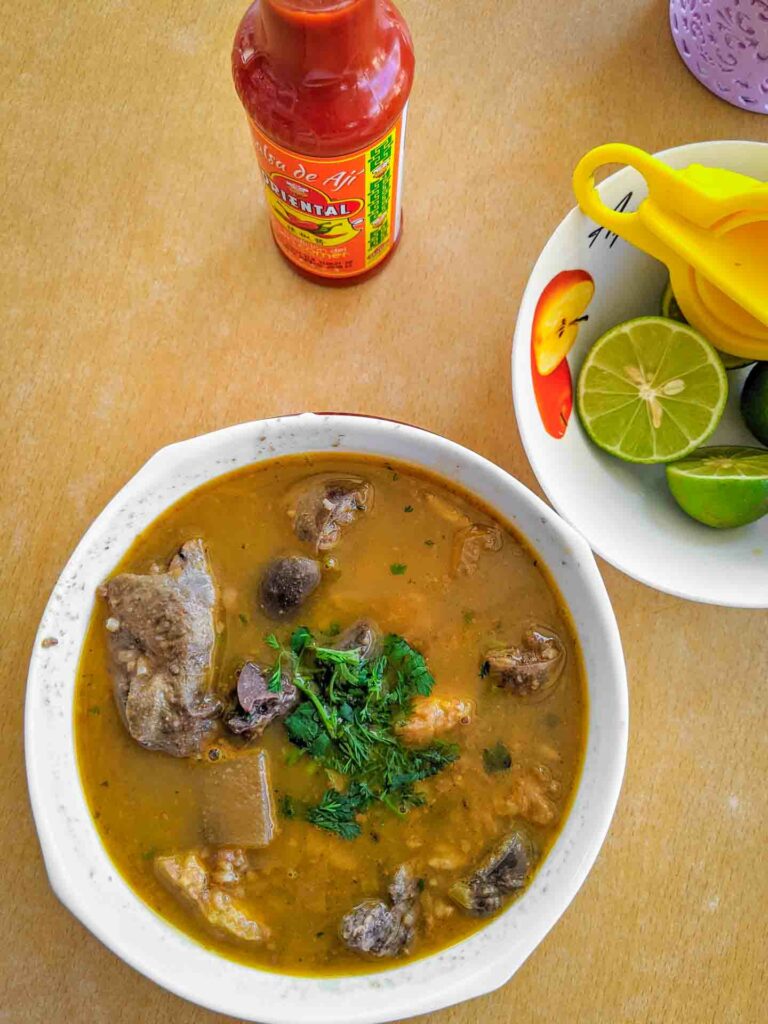
Caldo de Salchicha | Sausage Broth
Caldo de salchicha is a hearty sausage broth found across Ecuador. I first had it while heading to the southern coast of Ecuador, to the popular expat community of Salinas.
Caldo de salchicha, translates as hot dog soup or wiener soup. So it has a little bit of a double entendre.
The soup has Spanish influences, as it uses blood sausage called morcilla. But it’s a classic soup in Ecuador that uses the whole animal, including organs such as chicken heart, kidney and liver.
This dish is this rich brothy soup with morcilla, some vegetables, some fresh herbs and plantain on the coast.
This is yet another Ecuadorian hangover cure. If you are hungover and have an upset stomach this is exactly what you would want to try.
Caldo de Pata | Cow’s Feet Soup
This traditional soup in Ecuador is made with cow’s feet, believed to have healing properties.
It’s a rich, collagen-filled broth due to the cow feet that incorporates mote or yuca, cumin, oregano, achiote along with a sofrito of garlic and onion. Milk and peanut paste round out the flavor.
It’s a popular dish in the Andean region with has roots in both Indigenous and Spanish culinary practices.
Similar versions are found in other Latin American countries
Caldo de Cabeza de Morocho | Sheep Head Soup
Caldo de cabeza de morocho is a traditional soup made from sheep’s head. Mocho is the indigenous word for sheep. This is a delicacy in the highlands of Ecuador and I was lucky to find it at the 10 de Agosto market in Cuenca.
Sheep are not native to Ecuador and were brought by the Spanish. But they have been around for so long you can find Ecuadorian dishes with sheep. Although it is not as common.
The soup is a reflection of Indigenous and mestizo culinary traditions. Similar dishes are found in the Middle East, like the “Pacha” soup.
It’s a dish that speaks to the resourcefulness of local cuisine. Expect to find a milky broth with tripe, stomach lining and other offal.
It’s not a heavy dish as it uses green onion, cilantro and is fantastic with a bit of lime.
Aguado de Gallina | Chicken Soup
Aguado de gallina is a classic chicken soup found throughout Ecuador.
It’s made with rice, vegetables, and tender chicken hen. The dish has both Indigenous and Spanish influences.
Many Latin American countries have their chicken soup variants. It’s a universal remedy for cold days and common colds.
Sopa de Quinoa | Quinoa Soup
Quinoa is a nutritious Andean specialty from the Indigenous population. When the quinoa food craze hit North America media reports claimed that the demand was so high Ecuadorians didn’t have any for themselves.
But actually this isn’t true at all. Because it’s a grain became less popular, especially with younger generations.
Essentially Ecuadorians may grow quinoa, but it’s usually exported.
So I was excited to see sopa de quinoa at a hotel in Cotopaxi that features local Andean cuisine.
And frankly Ecuadorians need to bring this soup back because it’s fabulous and full of flavor.
It’s also very diverse as vegetables and sometimes meat are added to the mix. It’s a healthful, protein-packed dish ideal for the high-altitude climate.
Chupe de Pescado | Fish Chowder
Chupe de pescado is a rich, creamy fish chowder savored in Ecuador’s coastal areas. It’s similar to locro as it combines seafood with corn, cheese and starchy papa chola potatoes.
It’s a comforting bowl that highlights the coast’s fresh catch.
Parihuela | Spicy Seafood Soup
Parihuela is a spicy, aromatic seafood soup enjoyed on Ecuador’s coast. I tried it in Puerto Jeli in the El Oro Province after visiting Zaruma.
It’s an interesting area with a huge mangrove with so much shrimp, black clam, crab, calamari and various fish. Many people stop in just to eat.
This is an Ecuadorian soup but many would say it was taken from Peruvians as their dish is identical.
Ecuadorian Slang
Viche | Fish and Peanut Soup
Viche may be one of the most important Ecuadorian soups, especially along the coast.
It is a culinary representation of the Manabi province, perhaps the oldest soup and one known for its amazing seafood, plentiful plantains and prolific use of peanut.
In fact, during Easter people from the coast, known as costeños, do not make fanesca. It’s all about the viche.
It’s a fish and peanut broth that may include fish, seafood or both alongside plantains and sometimes vegetables or beans.
You’ll find it all over Manabi as locals eat it several times a week.
Pro tip: it’s known as biche de pescado as b and v are interchangeable in Ecuadorian Spanish.
Ensumacado | Seafood Soup
Ensumacado, also known as ensumacao is a hearty seafood soup from Esmeraldas, on Ecuador’s northern coast.
It brims with fresh ocean flavors, including fish and shellfish, seafood, chillangua herb unique to Esmeraldas and coconut.
Although I love food from all over Ecuador I must say it is best in Esmeraldas. I was able to visit when it was safe, for a very brief time. It makes me sad as the people are so lovely, the food is amazing and it has the best beaches.
This soup can be a bit heavy so be sure to share it. You’ll find it at traditional food restaurants around the beaches as locals love it.
Similar seafood soups are found in Colombia, known as cazuela de mariscos. It’s a coastal delicacy, rich with the taste of the sea.
Pin it: Ecuadorian Soup
